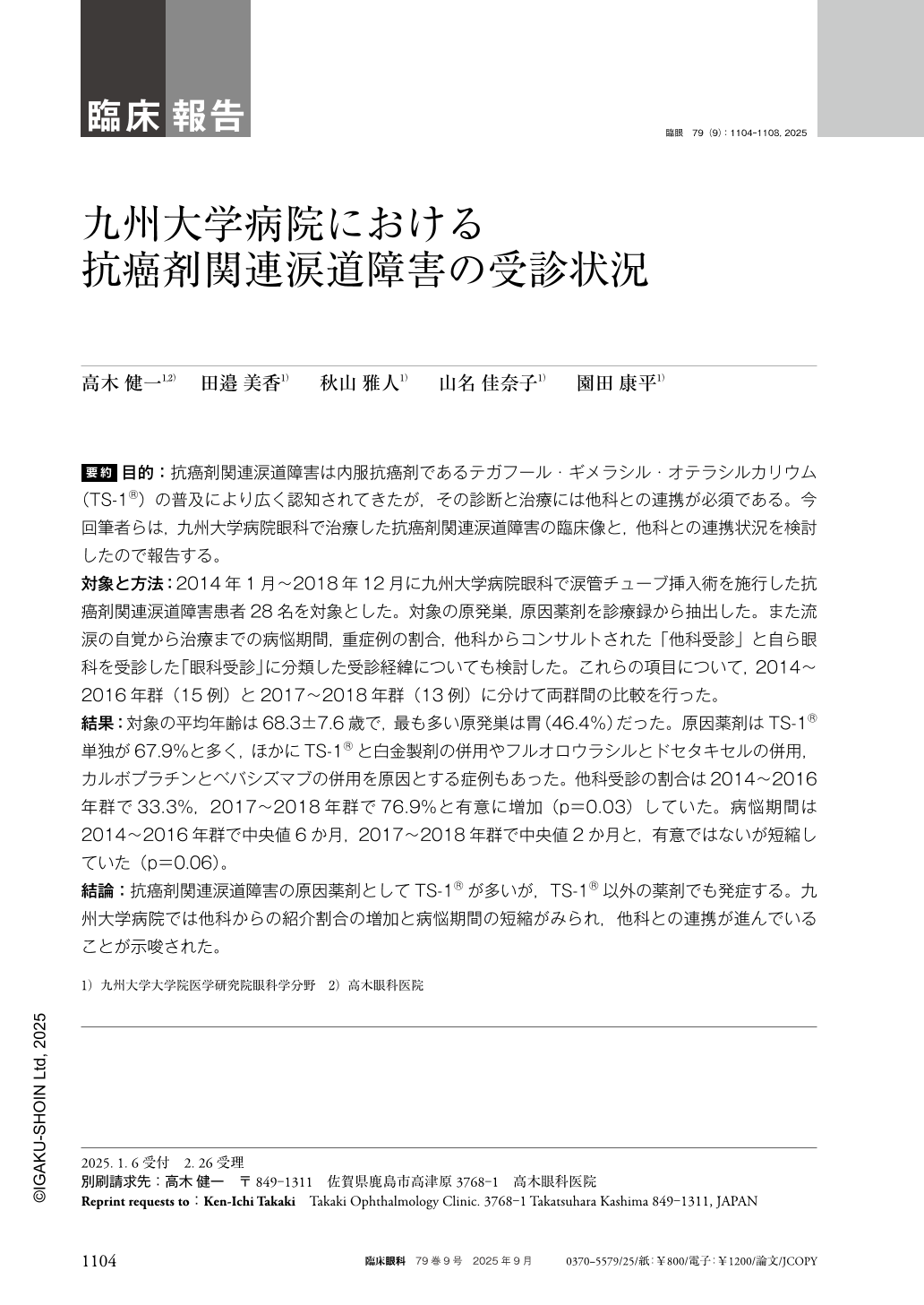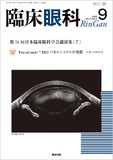Japanese
English
- 有料閲覧
- Abstract 文献概要
- 1ページ目 Look Inside
- 参考文献 Reference
要約 目的:抗癌剤関連涙道障害は内服抗癌剤であるテガフール・ギメラシル・オテラシルカリウム(TS-1®)の普及により広く認知されてきたが,その診断と治療には他科との連携が必須である。今回筆者らは,九州大学病院眼科で治療した抗癌剤関連涙道障害の臨床像と,他科との連携状況を検討したので報告する。
対象と方法:2014年1月〜2018年12月に九州大学病院眼科で涙管チューブ挿入術を施行した抗癌剤関連涙道障害患者28名を対象とした。対象の原発巣,原因薬剤を診療録から抽出した。また流涙の自覚から治療までの病悩期間,重症例の割合,他科からコンサルトされた「他科受診」と自ら眼科を受診した「眼科受診」に分類した受診経緯についても検討した。これらの項目について,2014〜2016年群(15例)と2017〜2018年群(13例)に分けて両群間の比較を行った。
結果:対象の平均年齢は68.3±7.6歳で,最も多い原発巣は胃(46.4%)だった。原因薬剤はTS-1®単独が67.9%と多く,ほかにTS-1®と白金製剤の併用やフルオロウラシルとドセタキセルの併用,カルボプラチンとベバシズマブの併用を原因とする症例もあった。他科受診の割合は2014〜2016年群で33.3%,2017〜2018年群で76.9%と有意に増加(p=0.03)していた。病悩期間は2014〜2016年群で中央値6か月,2017〜2018年群で中央値2か月と,有意ではないが短縮していた(p=0.06)。
結論:抗癌剤関連涙道障害の原因薬剤としてTS-1®が多いが,TS-1®以外の薬剤でも発症する。九州大学病院では他科からの紹介割合の増加と病悩期間の短縮がみられ,他科との連携が進んでいることが示唆された。
Abstract Purpose:Lacrimal drainage disorders associated with chemotherapy have become increasingly recognized due to the widespread use of the oral anticancer agent TS-1®. However, diagnosis and management require collaboration with other medical specialties. In this study, we investigated the clinical features of chemotherapy-related lacrimal drainage disorders treated at the Department of Ophthalmology, Kyushu University Hospital, and evaluated the state of interdepartmental collaboration.
Subjects and Methods:This study included 28 patients diagnosed with chemotherapy-related lacrimal drainage disorders who underwent lacrimal tube insertion at the Department of Ophthalmology, Kyushu University Hospital, between January 2014 and December 2018. Data on primary cancer sites and causative agents were extracted from medical records. Additionally, we analyzed the duration from symptom onset to treatment, the proportion of severe cases, and the referral pathways, categorizing cases as either “referral from other departments” or “direct ophthalmology visits.” These parameters were compared between two groups:the 2014-2016 cohort(15 cases) and the 2017-2018 cohort(13 cases).
Results:The mean age of the patients was 68.3±7.6 years, with gastric cancer being the most common primary site(46.4%). TS-1® alone accounted for 67.9% of the causative agents, while other combinations, including TS-1® with platinum agents, fluorouracil with docetaxel, and carboplatin with bevacizumab, were also identified. The proportion of referrals from other departments significantly increased from 33.3% in the 2014-2016 group to 76.9% in the 2017-2018 group(p=0.03). The median duration from symptom onset to treatment decreased from 6 months in the 2014-2016 group to 2 months in the 2017-2018 group, although this difference was not statistically significant(p=0.06).
Conclusion:While TS-1® was the most frequently implicated causative agent for chemotherapy-related lacrimal drainage disorders, other drugs were also involved. At Kyushu University Hospital, an increase in referrals from other departments and a reduction in the duration of symptoms before treatment suggested progress in interdepartmental collaboration.

Copyright © 2025, Igaku-Shoin Ltd. All rights reserved.


